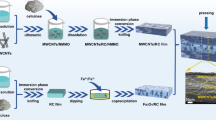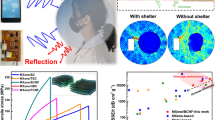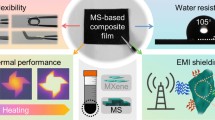Abstract
Polymers are widely employed to improve the mechanical properties of transition metal carbides and/or nitrides (MXenes) for constructing high-performance electromagnetic interference (EMI) shields. The challenges involve the insulating-polymer-induced compromise of electrical conductivity and EMI shielding performance of the MXene-based composites and the employment of nonrenewable, petrochemical polymers. Here, the one-dimensional, ultrafine, sustainable cellulose nanocrystals (CNCs) are efficiently employed to reinforce the MXene nanosheets, giving rise to high-strength, highly flexible biomimetic composites that maintain excellent electrical conductivity and EMI shielding effectiveness (SE). The freestanding MXene/CNC nanocomposites gain EMI SE values of 30 to 66 dB at thicknesses of approximately 2 to 14 µm, leading to ultrahigh specific SE and surface-specific SE values of 15,155 dB mm−1 and 54,125 dB cm2 g−1, respectively, which are comparable to those of the best EMI shields ever reported. Moreover, the excellent photothermal performance of the composite films was achieved, extending the application scenarios. Combined with the universal, facile, energy-efficient, and scalable ambient pressure drying preparation approach, the ultrathin, flexible, high-strength, and multifunctional CNC-reinforced MXene-based biomimetic films have shown great potential for applications in next-generation advanced flexible electronic or aerospace systems.

摘要
聚合物用于改善过渡金属碳化物和/或氮化物(MXenes)的力学 性能、构建高性能电磁(EMI)屏蔽结构面临以下挑战: 绝缘聚合物对 MXene基复合材料导电性和电磁屏蔽性能的影响以及聚合物的不可再 生性. 本文将一维、超细、可持续的纤维素纳米晶体(CNCs)用于增强 MXene纳米片, 从而制备出高强度、高柔性、同时兼顾优异导电性和 电磁屏蔽效能(SE)的仿生复合材料, 其性能优于目前报道的聚合物复 合材料. 在厚度仅为2–14 μm的情况下, MXene/CNC纳米复合材料的电 磁屏蔽效能分别达到30–66 dB, 比屏蔽效能和面比屏蔽效能分别达到 15,155 dB mm−1和54,125 dB cm2 g−1. 复合薄膜具有良好的光热性能, 扩展了其应用场景. 结合简便、高效、可规模化的常压干燥制备方法 得到的超薄、柔韧、高强度、多功能的CNC增强MXene基仿生薄膜在 下一代先进电子或航空航天领域显示出巨大的应用潜力.
Similar content being viewed by others
References
Iqbal A, Shahzad F, Hantanasirisakul K, et al. Anomalous absorption of electromagnetic waves by 2D transition metal carbonitride Ti3CNTx (MXene). Science, 2020, 369: 446–450
De France K, Zeng Z, Wu T, et al. Functional materials from nanocellulose: Utilizing structure-property relationships in bottom-up fabrication. Adv Mater, 2020, 33: 2000657
Chen Z, Xu C, Ma C, et al. Lightweight and flexible graphene foam composites for high-performance electromagnetic interference shielding. Adv Mater, 2013, 25: 1296–1300
Zhou Z, Song Q, Huang B, et al. Facile fabrication of densely packed Ti3C2 MXene/nanocellulose composite films for enhancing electromagnetic interference shielding and electro-/photothermal performance. ACS Nano, 2021, 15: 12405–12417
Guan X, Yang Z, Zhou M, et al. 2D MXene nanomaterials: Synthesis, mechanism, and multifunctional applications in microwave absorption. Small Struct, 2022, 3: 2200102
Zhao Y, Ji G. Multi-spectrum bands compatibility: New trends in stealth materials research. Sci China Mater, 2022, 65: 2936–2941
Zeng Z, Jin H, Chen M, et al. Lightweight and anisotropic porous MWCNT/WPU composites for ultrahigh performance electromagnetic interference shielding. Adv Funct Mater, 2016, 26: 303–310
Song Q, Ye F, Yin X, et al. Carbon nanotube-multilayered graphene edge plane core-shell hybrid foams for ultrahigh-performance electromagnetic-interference shielding. Adv Mater, 2017, 29: 1701583
Zeng ZH, Wu N, Wei JJ, et al. Porous and ultra-flexible crosslinked mxene/polyimide composites for multifunctional electromagnetic interference shielding. Nano-Micro Lett, 2022, 14: 59
Al-Saleh MH, Sundararaj U. Electromagnetic interference shielding mechanisms of CNT/polymer composites. Carbon, 2009, 47: 1738–1746
Zeng Z, Wang C, Wu T, et al. Nanocellulose assisted preparation of ambient dried, large-scale and mechanically robust carbon nanotube foams for electromagnetic interference shielding. J Mater Chem A, 2020, 8: 17969–17979
Wei Q, Pei S, Qian X, et al. Superhigh electromagnetic interference shielding of ultrathin aligned pristine graphene nanosheets film. Adv Mater, 2020, 32: 1907411
Zhao S, Zhang HB, Luo JQ, et al. Highly electrically conductive three-dimensional Ti3C2Tx MXene/reduced graphene oxide hybrid aerogels with excellent electromagnetic interference shielding performances. ACS Nano, 2018, 12: 11193–11202
Zhou T, Wu C, Wang Y, et al. Super-tough MXene-functionalized graphene sheets. Nat Commun, 2020, 11: 2077
Yousefi N, Sun X, Lin X, et al. Highly aligned graphene/polymer nanocomposites with excellent dielectric properties for high-performance electromagnetic interference shielding. Adv Mater, 2014, 26: 5480–5487
Zeng Z, Wang C, Siqueira G, et al. Nanocellulose-MXene biomimetic aerogels with orientation-tunable electromagnetic interference shielding performance. Adv Sci, 2020, 7: 2000979
Chung DDL. Electromagnetic interference shielding effectiveness of carbon materials. Carbon, 2001, 39: 279–285
Thomassin JM, Jérôme C, Pardoen T, et al. Polymer/carbon based composites as electromagnetic interference (EMI) shielding materials. Mater Sci Eng-R-Rep, 2013, 74: 211–232
Carey M, Barsoum MW. MXene polymer nanocomposites: A review. Mater Today Adv, 2021, 9: 100120
Regev O, ElKati PNB, Loos J, et al. Preparation of conductive nanotube-polymer composites using latex technology. Adv Mater, 2004, 16: 248–251
Li N, Huang Y, Du F, et al. Electromagnetic interference (EMI) shielding of single-walled carbon nanotube epoxy composites. Nano Lett, 2006, 6: 1141–1145
Zhang Y, Kong J, Gu J. New generation electromagnetic materials: Harvesting instead of dissipation solo. Sci Bull, 2022, 67: 1413–1415
Li B, Wang F, Wang K, et al. Metal sulfides based composites as promising efficient microwave absorption materials: A review. J Mater Sci Tech, 2022, 104: 244–268
Tian H, Qiao J, Yang Y, et al. ZIF-67-derived Co/C embedded boron carbonitride nanotubes for efficient electromagnetic wave absorption. Chem Eng J, 2022, 450: 138011
Arjmand M, Apperley T, Okoniewski M, et al. Comparative study of electromagnetic interference shielding properties of injection molded versus compression molded multi-walled carbon nanotube/polystyrene composites. Carbon, 2012, 50: 5126–5134
Hsiao ST, Ma CCM, Tien HW, et al. Using a non-covalent modification to prepare a high electromagnetic interference shielding performance graphene nanosheet/water-borne polyurethane composite. Carbon, 2013, 60: 57–66
Wang L, Qiu H, Song P, et al. 3D Ti3C2Tx MXene/C hybrid foam/epoxy nanocomposites with superior electromagnetic interference shielding performances and robust mechanical properties. Compos Part A-Appl Sci Manufact, 2019, 123: 293–300
Rajavel K, Luo S, Wan Y, et al. 2D Ti3C2Tx MXene/polyvinylidene fluoride (PVDF) nanocomposites for attenuation of electromagnetic radiation with excellent heat dissipation. Compos Part A-Appl Sci Manufact, 2020, 129: 105693
Weng C, Xing T, Jin H, et al. Mechanically robust ANF/MXene composite films with tunable electromagnetic interference shielding performance. Compos Part A-Appl Sci Manufact, 2020, 135: 105927
Wang L, Chen L, Song P, et al. Fabrication on the annealed Ti3C2Tx MXene/epoxy nanocomposites for electromagnetic interference shielding application. Compos Part B-Eng, 2019, 171: 111–118
Al-Saleh MH, Saadeh WH, Sundararaj U. EMI shielding effectiveness of carbon based nanostructured polymeric materials: A comparative study. Carbon, 2013, 60: 146–156
Shahzad F, Alhabeb M, Hatter CB, et al. Electromagnetic interference shielding with 2D transition metal carbides (MXenes). Science, 2016, 353: 1137–1140
Han M, Shuck CE, Rakhmanov R, et al. Beyond Ti3C2Tx: MXenes for electromagnetic interference shielding. ACS Nano, 2020, 14: 5008–5016
Nepal D, Kennedy WJ, Pachter R, et al. Toward architected nanocomposites: MXenes and beyond. ACS Nano, 2021, 15: 21–28
Song P, Liu B, Qiu H, et al. MXenes for polymer matrix electromagnetic interference shielding composites: A review. Compos Commun, 2021, 24: 100653
Zhang Y, Ma Z, Ruan K, et al. Multifunctional Ti3C2Tx-(Fe3O4/polyimide) composite films with Janus structure for outstanding electromagnetic interference shielding and superior visual thermal management. Nano Res, 2022, 15: 5601–5609
Zhang Y, Ruan K, Gu J. Flexible sandwich-structured electromagnetic interference shielding nanocomposite films with excellent thermal conductivities. Small, 2021, 17: 2101951
Liu J, Zhang HB, Sun R, et al. Hydrophobic, flexible, and lightweight MXene foams for high-performance electromagnetic-interference shielding. Adv Mater, 2017, 29: 1702367
Shui X, Chung DDL. Nickel filament polymer-matrix composites with low surface impedance and high electromagnetic interference shielding effectiveness. J Elec Materi, 1997, 26: 928–934
Chen H, Wen Y, Qi Y, et al. Pristine titanium carbide MXene films with environmentally stable conductivity and superior mechanical strength. Adv Funct Mater, 2019, 30: 1906996
Zhao X, Vashisth A, Prehn E, et al. Antioxidants unlock shelf-stable Ti3C2Tx (MXene) nanosheet dispersions. Matter, 2019, 1: 513–526
Wan YJ, Rajavel K, Li XM, et al. Electromagnetic interference shielding of Ti3C2Tx MXene modified by ionic liquid for high chemical stability and excellent mechanical strength. Chem Eng J, 2021, 408: 127303
Zhang J, Kong N, Uzun S, et al. Scalable manufacturing of freestanding, strong Ti3C2Tx MXene films with outstanding conductivity. Adv Mater, 2020, 32: 2001093
Xu H, Yin X, Li X, et al. Lightweight Ti2CTx MXene/poly(vinyl alcohol) composite foams for electromagnetic wave shielding with absorption-dominated feature. ACS Appl Mater Interfaces, 2019, 11: 10198–10207
Zhou Z, Liu J, Zhang X, et al. Ultrathin MXene/calcium alginate aerogel film for high-performance electromagnetic interference shielding. Adv Mater Interfaces, 2019, 6: 1802040
Xie F, Jia F, Zhuo L, et al. Ultrathin MXene/aramid nanofiber composite paper with excellent mechanical properties for efficient electromagnetic interference shielding. Nanoscale, 2019, 11: 23382–23391
Ling Z, Ren CE, Zhao MQ, et al. Flexible and conductive MXene films and nanocomposites with high capacitance. Proc Natl Acad Sci USA, 2014, 111: 16676–16681
Li T, Chen C, Brozena AH, et al. Developing fibrillated cellulose as a sustainable technological material. Nature, 2021, 590: 47–56
Wu T, Zeng Z, Siqueira G, et al. Dual-porous cellulose nanofibril aerogels via modular drying and cross-linking. Nanoscale, 2020, 12: 7383–7394
Zhan Z, Song Q, Zhou Z, et al. Ultrastrong and conductive MXene/cellulose nanofiber films enhanced by hierarchical nano-architecture and interfacial interaction for flexible electromagnetic interference shielding. J Mater Chem C, 2019, 7: 9820–9829
Tian W, VahidMohammadi A, Reid MS, et al. Multifunctional nanocomposites with high strength and capacitance using 2D MXene and 1D nanocellulose. Adv Mater, 2019, 31: 1902977
Cao WT, Chen FF, Zhu YJ, et al. Binary strengthening and toughening of MXene/cellulose nanofiber composite paper with nacre-inspired structure and superior electromagnetic interference shielding properties. ACS Nano, 2018, 12: 4583–4593
Yang W, Zhao Z, Wu K, et al. Ultrathin flexible reduced graphene oxide/cellulose nanofiber composite films with strongly anisotropic thermal conductivity and efficient electromagnetic interference shielding. J Mater Chem C, 2017, 5: 3748–3756
Cao W, Ma C, Tan S, et al. Ultrathin and flexible CNTs/MXene/cellulose nanofibrils composite paper for electromagnetic interference shielding. Nano-Micro Lett, 2019, 11: 72
Xin W, Xi GQ, Cao WT, et al. Lightweight and flexible MXene/CNF/silver composite membranes with a brick-like structure and high-performance electromagnetic-interference shielding. RSC Adv, 2019, 9: 29636–29644
Liu Q, Zhang Y, Liu Y, et al. Ultrathin, biomimetic multifunctional leaflike silver nanowires/Ti3C2Tx MXene/cellulose nanofibrils nanocomposite film for high-performance electromagnetic interference shielding and thermal management. J Alloys Compd, 2021, 860: 158151
Aeby X, Poulin A, Siqueira G, et al. Fully 3D printed and disposable paper supercapacitors. Adv Mater, 2021, 33: 2101328
Hausmann MK, Siqueira G, Libanori R, et al. Complex-shaped cellulose composites made by wet densification of 3D printed scaffolds. Adv Funct Mater, 2020, 30: 1904127
Hausmann MK, Rühs PA, Siqueira G, et al. Dynamics of cellulose nanocrystal alignment during 3D printing. ACS Nano, 2018, 12: 6926–6937
Zeng Z, Mavrona E, Sacré D, et al. Terahertz birefringent biomimetic aerogels based on cellulose nanofibers and conductive nanomaterials. ACS Nano, 2021, 15: 7451–7462
Liu R, Miao M, Li Y, et al. Ultrathin biomimetic polymeric Ti3C2Tx MXene composite films for electromagnetic interference shielding. ACS Appl Mater Interfaces, 2018, 10: 44787–44795
Ma Z, Xiang X, Shao L, et al. Multifunctional wearable silver nanowire decorated leather nanocomposites for joule heating, electromagnetic interference shielding and piezoresistive sensing. Angew Chem Int Ed, 2022, 61: e202200705
Zhang Y, Gu J. A perspective for developing polymer-based electromagnetic interference shielding composites. Nano-Micro Lett, 2022, 14: 89
Cui Z, Gao C, Fan Z, et al. Lightweight MXene/cellulose nanofiber composite film for electromagnetic interference shielding. J Elec Materi, 2021, 50: 2101–2110
Yun T, Kim H, Iqbal A, et al. Electromagnetic shielding of monolayer MXene assemblies. Adv Mater, 2020, 32: 1906769
Chen X, Zhou M, Zhao Y, et al. Morphology control of eco-friendly chitosan-derived carbon aerogels for efficient microwave absorption at thin thickness and thermal stealth. Green Chem, 2022, 24: 5280–5290
Zhou M, Wang J, Wang G, et al. Lotus leaf-inspired and multifunctional Janus carbon Felt@Ag composites enabled by in situ asymmetric modification for electromagnetic protection and low-voltage joule heating. Compos Part B-Eng, 2022, 242: 110110
Yang Y, Wu N, Li B, et al. Biomimetic porous MXene sediment-based hydrogel for high-performance and multifunctional electromagnetic interference shielding. ACS Nano, 2022, 16: 15042–15052
Tan C, Dong Z, Li Y, et al. A high performance wearable strain sensor with advanced thermal management for motion monitoring. Nat Commun, 2020, 11: 3530
Acknowledgements
This work was financially supported by the National Key R&D Program of China (2021YFB3502500), the Natural Science Foundation of Shandong Province (2022HYYQ-014), the Provincial Key Research and Development Program of Shandong (2019JZZY010312 and 2021ZLGX01), the “20 Clauses about Colleges and Universities (new)” (Independent Training of Innovation Team) Program of Jinan (2021GXRC036), the Joint Laboratory Project of Electromagnetic Structure Technology (637-2022-70-F-037), and Qilu Young Scholar Program of Shandong University (31370082163127). The authors acknowledge the assistance of Shandong University Testing and Manufacturing Center for Advanced Materials.
Author information
Authors and Affiliations
Contributions
Wu N designed the work and engineered the samples; Wu N and Li B performed the experiments; Wu N and Li B performed the data analysis; Wu N, Li B, and Pan F wrote the paper with support from Zeng Z and Liu J; Wu N, Li B, and Zhang R contributed to the theoretical analysis. All authors contributed to the general discussion.
Corresponding authors
Additional information
Zhihui Zeng received his PhD degree in materials science and engineering from the National Center for Nanoscience and Technology (NCNST), University of Chinese Academy of Sciences, Beijing, China in 2016. Following his work as a postdoctoral research fellow at Nanyang Technological University, Singapore, and Swiss Federal Laboratories for Materials Science and Technology (Empa), Switzerland, he currently works at Shandong University, China. His research interests include the design, fabrication and application of polymer-based nanocomposites, nanostructured assemblies, and cellular materials.
Jiurong Liu obtained his PhD degee from Osaka University in 2004. Then, he worked as a postdoctoral fellow at the University of California at Los Angeles until 2008 before beginning his career as a full professor at the School of Materials Science and Engineering, Shandong University. His research interests include the synthesis of hybrid nanomaterials for energy storage and electromagnetic applications.
Na Wu obtained her PhD degree from the Department of Chemistry and Applied Biosciences, ETH Zurich, Switzerland, in 2021. Now, she works at ETH zurich as a postdoctoral fellow. Her research interests include the design and preparation of electromagnetic shielding materials.
Bin Li received his Bachelor’s degree from Qingdao University of Technology in 2019. He is currently pursuing his PhD degree under the supervision of Professor Jiurong Liu at Shandong University. His research interests focus on the design, fabrication, and application of electromagnetic functional materials.
Conflict of interest
The authors declare that they have no conflict of interest.
Supplementary information
Supplementary data are available in the online version of the paper.
Supporting Information
40843_2022_2279_MOESM1_ESM.pdf
Ultrafine cellulose nanocrystal-reinforced MXene biomimetic composites for multifunctional electromagnetic interference shielding
Rights and permissions
About this article
Cite this article
Wu, N., Li, B., Pan, F. et al. Ultrafine cellulose nanocrystal-reinforced MXene biomimetic composites for multifunctional electromagnetic interference shielding. Sci. China Mater. 66, 1597–1606 (2023). https://doi.org/10.1007/s40843-022-2279-3
Received:
Accepted:
Published:
Issue Date:
DOI: https://doi.org/10.1007/s40843-022-2279-3




